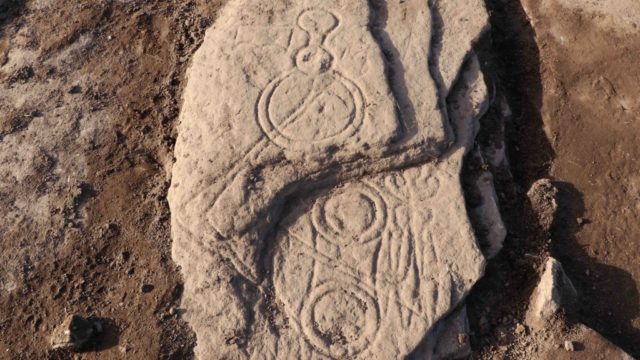An eventful evening turned into an emotional one when archeologists uncovered a stone covered in ancient symbols that the Picts designed about 1,500 years ago.


The Picts were an Indigenous group of people who lived in northern Scotland. When the Romans tried to seize Scotland (which was then known as Caledonia), the Picts held their territory on multiple occasions and fought off the invaders.
The name given to these people means ‘Painted Ones’ in Latin. At one point, the Picts had the largest kingdom in Dark Age Scotland. Very little is known about the Picts, who disappeared from the historical record around 900 CE. Chances are their culture was assimilated by the Gaels around this time.
It’s no wonder the Picts’ symbols were such an exciting find. Only about 200 Pict stones are known to archeologists today. The excavation team unexpectedly uncovered the 5.5-foot-long (1.7 meters) stone while doing a geophysical survey in the small village of Aberlemno, a town with Pictish roots.
The stone depicts many shapes showing abstract Pictish symbols. These symbols include triple ovals, a comb and mirror, and a crescent and double discs. A few carved symbols overlap, suggesting that they were carved in different periods.
The discovery happened in early 2020 as archeologists surveyed the area as part of the Comparative Kingship project. This project is a five-year investigation into the early medieval kingdoms in Northern England and Ireland. The team’s equipment began picking up strange anomalies which could suggest a settlement’s remains might lie underneath the grass they were standing on.
The team dug a small pit to see what was underneath the ground. It was then they discovered the carved Pictish stone. University of Aberdeen archeology Zack Hinckley remembered his excitement, recalling: “I just brushed my hand, and there was a symbol. And we had a freakout.”
The team had hoped to immediately excavate their discovery to learn more about it. Unfortunately, due to COVID-19 restrictions, the research team had to put their plans on hold. It took several months for the researchers to return to verify their discovery. Throughout February and into March 2022, archeologists have excavated parts of the settlement and removed the stone from its final resting place.
In the past, Pictish artifacts have been often “dug up by farmers ploughing fields or during the course of a road building,” explained Professor Gordon Noble in a statement. Since the team came across this artifact naturally, they can begin to gather much more detailed context and evidence about how the Picts lived.
It remains unclear what the symbols mean, but the “best guess is that they are a naming system representing Pictish names,” Gordon Noble explained to Live Science. The carvings date back to the fifth or sixth century CE.
The Pictish artifact is truly a once-in-a-lifetime discovery. Research fellow Dr. Jame O’Driscoll, who initially discovered the stone, remembered the day’s feelings. “We thought we’d just uncover a little bit more before we headed off for the day. We suddenly saw a symbol. There was lots of screaming. Then we found more symbols and there was more screaming and a little bit of crying! It’s a feeling that I’ll probably never have again on an archeological site. It’s a find of that scale.”
More from us: Multiple Royal Graves Dating Back to the 5th Century Discovered in Britain
The stone has been moved to the Graciela Ainsworth conservation lab located in Edinburgh where a more detailed analysis will be conducted.

